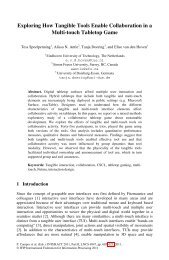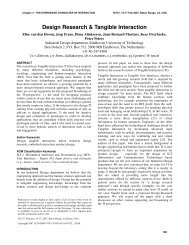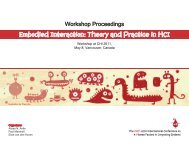Sissy - Elise van den Hoven
Sissy - Elise van den Hoven
Sissy - Elise van den Hoven
Create successful ePaper yourself
Turn your PDF publications into a flip-book with our unique Google optimized e-Paper software.
character: visitors experienced both a passive attitude<br />
described with ‘go away’ and an active attitude such as<br />
‘curious’. The fact that the greater part of participants<br />
scored their feeling as being ‘relaxed’ in the interviews<br />
reflects the goal of slow technology but it is unclear<br />
whether visitors experienced relaxation because of <strong>Sissy</strong><br />
or because of attending the festival in general.<br />
Misunderstanding the behaviour by explaining the<br />
movement of dots by light movement shows visitors did<br />
not notice <strong>Sissy</strong> responded to their movements. This<br />
might have been influenced by other artworks at the<br />
festival, since several other works did respond to light<br />
and therefore the visitors were expecting similar<br />
behaviours of <strong>Sissy</strong>.<br />
Experimenting with the implementation of ‘slow<br />
technology’ in a public space shows new findings on the<br />
relation between context and ‘slow technology’. The<br />
results raise misunderstanding about the interaction that<br />
might possibly be caused by the amount of distraction.<br />
This indicates that not every environment matches the<br />
design vision of ‘slow technology’, simply because<br />
<strong>Sissy</strong>’s slow technology did not match visitors’<br />
expectations. <strong>Sissy</strong> differed from other installations by<br />
not having spectacular interactions and obvious feedback<br />
but visitors still expected this.<br />
It was assumed that visitors would understand that they<br />
could interact with the installation but the results show<br />
otherwise. The corner <strong>Sissy</strong> was situated in was shared<br />
with a shop and another installation resulting in a<br />
crowded area around <strong>Sissy</strong>. It was concluded that there<br />
was interference with individual interactions, which<br />
resulted in a twisted and incomprehensible interaction for<br />
the visitors. Together with the conclusions about this<br />
context we suggest a new environment for such an<br />
installation: the environment could have worked if it<br />
would have been a passage or open space but not a<br />
corner, the area needed to be big enough for better<br />
distinction of the 6 detection areas (around 6mx6m) and<br />
the distraction needed to be minimal. Examples of public<br />
spaces, but not at festivals could include: hospitals,<br />
waiting rooms, hotel lobbies or libraries.<br />
The questionnaire showed a generally positive response<br />
of visitors to <strong>Sissy</strong> although they experienced <strong>Sissy</strong> to be<br />
complex. This could be explained by the questionnaire<br />
participants’ mentioning of <strong>Sissy</strong>’s nice aesthetics: the<br />
flipping dots in combination with the beamer projection<br />
resulted in a colourful installation that is worth looking at<br />
without understanding the interaction.<br />
CONCLUSION<br />
In this paper we described the design and implementation<br />
of an interactive installation at an art and technology<br />
festival. The semi-structured interviews and<br />
questionnaires about visitors’ experience of <strong>Sissy</strong> resulted<br />
in the following conclusions: <strong>Sissy</strong>’s character<br />
descriptions were categorized in three groups.<br />
Explanations contained ‘negative’ characters like:<br />
4<br />
‘scared, go away and fear’, but also ‘positive’ ones:<br />
happy, curious and playful. In-between characters were<br />
also mentioned: aware, unpredictable, shy and keep an<br />
eye on you. Visitors indicated that they felt relaxed after<br />
experiencing <strong>Sissy</strong>. Other interesting findings show the<br />
misunderstanding by the greater part of visitors of <strong>Sissy</strong>’s<br />
behaviour (disappearing when coming too close,<br />
appearing when taking more distance). The majority of<br />
the visitors spent less than one minute exploring <strong>Sissy</strong><br />
and seemed biased by other installations that responded to<br />
light and did not notice <strong>Sissy</strong> responded to their body<br />
movement.<br />
The questionnaire results showed the visitors had a<br />
positive opinion about <strong>Sissy</strong> in general and they<br />
considered <strong>Sissy</strong> to be alive or lively. Concluding the<br />
interview, questionnaire and observations show that we<br />
cannot define <strong>Sissy</strong> as being ‘slow technology’ since we<br />
could not confirm whether <strong>Sissy</strong> contributed to the<br />
relaxed feeling of the festival visitors, however the<br />
visitors were relaxed.<br />
ACKNOWLEDGEMENTS<br />
We thank Ingrid Vogels for support with the design of the<br />
interview, Bram Knaapen and Tomasso Gritti for<br />
programming the camera’s algorithms.<br />
REFERENCES<br />
Beesley P., Ohrstedt P. and Isaacs H. Hylozoic Ground:<br />
Liminal Responsive Architecture. Riverside<br />
Architectural Press 196 (2010).<br />
Boerdonk, K. <strong>van</strong>, Tieben, R., Klooster, S. and <strong>Hoven</strong>, E.<br />
<strong>van</strong> <strong>den</strong>. Contact through Canvas: an Entertaining<br />
Encounter. Personal and Ubiquitous Computing 13<br />
(2009), 551-567.<br />
Bolter, J. D. and Gromala, D. Windows and Mirrors:<br />
Interaction Design, Digital Art, and the Myth of<br />
Transparency. Leonardo 182. MIT Press (2003).<br />
Hallnäs L. and Redström J.. Slow technology - Design for<br />
reflection. Personal and Ubiquitous Computing 5, 3<br />
(2001), 201-212.<br />
rAndom International. Audience, http://www.randominternational.com/audience-private-collection/<br />
Redström, J. Skog, T. and Hallnäs, L. Informative Art:<br />
Using Amplified Artworks as Information Displays. In<br />
Proc. DARE 2000, ACM Press (2000), 103-114.<br />
Rozin, D. Bitforms, http://www.bitforms.com/danielrozin-gallery.html<br />
Rydarowski A., Samanci O. and Mazalek A. Murmur:<br />
Kinetic Relief Sculpture, Multi-Sensory Display,<br />
Listening Machine. In Proc. TEI’08, (2008), 231-238.<br />
STRP festival, http://www.strp.nl/strp/content/index<br />
Troika. Cloud 2008, http://troika.uk.com/cloud<br />
Winkler T. Participation and response in movementsensing<br />
installations. In Proc. ICMC, (2000), 137-140.



![Download 1.8 MB [pdf] - Elise van den Hoven](https://img.yumpu.com/18078175/1/190x245/download-18-mb-pdf-elise-van-den-hoven.jpg?quality=85)

![Download 0.2 MB [pdf] - Elise van den Hoven](https://img.yumpu.com/18078145/1/182x260/download-02-mb-pdf-elise-van-den-hoven.jpg?quality=85)
![Download 0.1 MB [pdf] - Elise van den Hoven](https://img.yumpu.com/18078125/1/190x146/download-01-mb-pdf-elise-van-den-hoven.jpg?quality=85)
![Download 1.9 MB [pdf] - Elise van den Hoven](https://img.yumpu.com/18078041/1/182x260/download-19-mb-pdf-elise-van-den-hoven.jpg?quality=85)

